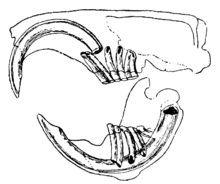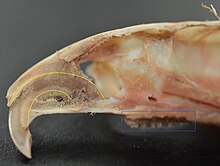User:Dizzle32/sandbox
'''bold'''
[[Boldness|bold]]
Endostyle: Questions and Comments[edit]
Questions: - What exactly is an Endostyle composed of? - How does it function differently/similarly in other species? - What is the perceived evolutionary history of the endostyle to a thyroid gland in vertebrates
Comments: - It could use visuals! Lots of visuals. Especially the different endostyles of the different species/phylum. - Need to be more detailed on the mechanism as to how it helps gather food. - Maybe include its importance as one of the synapomorphies in chordates to possibly further support the the relationship between urochordates, cephalocordates, and vertebrate subphylum. - Found a great article that mentions the presence of rough endoplasmic reticulum in the glandular cells of the endostyle in tunicates that supports the hypothesis that it aids in digestion because of the digestive enzyme it produces [1] - This article talks about the possible evolutionary history of endostyles, as well as the other synapomorphies, in they phyla Chordata. It's suggesting that endostyles and other structures within the digestive system were one of the first structures that were included in both chordates and non-chordates. [2]
Hackles article[edit]
Dogs may raise their hackles as a sign of aggressive behavior to show their dominance over conspecifics [3]. Raised hackles is a behavior that can also be observed in dominant wolves who show aggression towards subordinate wolves [4].
Dissection Preferences[edit]
1. Microbat: To be honest, I'm a fan of Batman! But in the sense of comparative anatomy, I think it's quite interesting how bats are the only "flying" mammals that are extant (not including the gliding squirrels since they don't flap their "wings"), so it would be interesting to see the musculature that enables them to fly.
Possible subtopics to edit/consider:
- Tragus (ear) This article is rated as a start-class, and of low-importance, but could use some editing to incorporate other animals that possess a tragus, and not just humans.
- patagium This article is considered a stub-class, and of low-importance. It could use some more context as to what makes up this structure in animals, and what the evolutionary history may be.
- Hematophagy It's a start-class and mid-importance article that could use some more information in the biological benefits in vampire bats and how these bats evolved this characteristic.
2. Rat: I think it's quite interesting that rats are known to spread many diseases and just filth, but I would like to know what makes them capable of thriving in such harsh environments, and what can help protect them from contracting some diseases? The article itself lacks the anatomical features of rats.
- Muroidea A stub-class and low-importance article. Possibly edit the defining features of this superfamily.
- Murinae C-class and mid-importance article. Needs more content, and possibly images.
- Massater muscle Start-class and mid-importance article. Maybe add some content for other mammals, such as rats.
3. Chimaera: I wonder why they're called chimaeras, a term used in Greek mythology as well (Chimaera), but it is interesting how their tails don't look like their relatives (i.e. sharks), and their fins look more like bony fish fins.
- Clasper Start-class and mid-importance article. Possibly include comparisons and differences in other species that utilize the clasper.
- Operculum (fish) Stub-class and mid-importance article. Could add more context and images.
- Vitrodentine Stub-class and low-importance article. Needs a lot more context, images, and references to organism that possess this feature.
Rat: Incisors Edit[edit]
Though the information under the rodent section within the tooth article contains the general characteristic of the rodent incisor, I would like to add more specificity - that is, add another terminology and the interior structure - to the teleological explanation as to why rodents can constantly gnaw on food/things.
I intend to add images to the article such as this, but from our own rodent:

Proposed edit:
Rodents have upper and lower hypselodont incisors - that is, these teeth have the ability to constantly grow a crown (enamel) while not having properly formed roots. Therefore, the rate of wear and tooth growth are at equilibrium [5].
The microstructure of rodent incisor enamel has shown to be useful in studying the phylogeny and systematics of rodents because of its independent evolution from the other dental traits. The enamel on rodent incisors are composed of two layers: the inner portio interna (PI) with Hunter-Schreger bands (HSB) and an outer portio externa (PE) with radial enamel. The radial enamel contain prism-like structures that are parallel to each other and grow directed towards the occlusal surface. The HSB also contain prisms, though the layers may vary in thickness and orientation: some run parallel to each other, while others may intersect. In rodent incisors, there are three types of HSB that have been identified: pauciserial, uniserial, and multiserial [6]
Feedback Responses[edit]
I had comments on further defining the terms I used since they seem a bit to dense, and to possibly provide links that could further expand on these terms (portio externa, portio interna, and Hunter-Schreger bands). There was also the question of why/how rodent incisors can grow without set roots, and what may be an adaptive reason for rodents to have this feature.
I fully agree and appreciate these comments and I will seek to find more resources to further explain the terms in a more general sense and also provide links within Wikipedia so the content within the section I intend to edit is not too extensive.
I have found additional articles that I plan on using to provide more insight specifically about the layers of the rodent's enamel, and I plan on using a wiki-link for the Hunter-Schreger band mentioned in my draft. Here are the possible resources that I would use:
- Diversity of enamel microstructure [7]
- Relationship between cell proliferation and eruption of incisors [8]
- Age and eruption rate of incisor teeth [9]
Draft #2[edit]
Images to use:







Talk[edit]
Practice signature Dizzle32 (talk) 05:06, 25 February 2017 (UTC)
Notes[edit]
- ^ Godeaux, Jean (1989). "Functions of the endostyle in the tunicates". Bulletin of Marine Science. 45 (2): 228–242.
{{cite journal}}:|access-date=requires|url=(help) - ^ Satoh, N.; Rokhsar, D.; Nishikawa, T. (17 September 2014). "Chordate evolution and the three-phylum system". Proceedings of the Royal Society B: Biological Sciences. 281 (1794): 20141729–20141729. doi:10.1098/rspb.2014.1729.
{{cite journal}}:|access-date=requires|url=(help) - ^ Svartberg, Kenth; Forkman, Björn (October 20, 2002). "Personality traits in the domestic dog (Canis familiaris)". Applied Animal Behaviour Science. 79 (2): 133–155.
{{cite journal}}:|access-date=requires|url=(help) - ^ Barrett, edited by James Serpell ; pencil drawings by Priscilla (1999). The Domestic dog : its evolution, behaviour, and interactions with people (Repr. ed.). Cambridge, England: Cambridge University Press. p. 118. ISBN 9780521425377.
{{cite book}}:|access-date=requires|url=(help);|first1=has generic name (help)CS1 maint: multiple names: authors list (link) - ^ Cox, Philip; Hautier, Lionel (2015). Evolution of the Rodents: Advances in Phylogeny, Functional Morphology and Development. Cambridge University Press. p. 482. ISBN 9781107044333.
{{cite book}}:|access-date=requires|url=(help) - ^ Martin, Thomas (September 1999). "Evolution of Incisor Enamel Microstructure in Theridomyidae (Rodentia)". Journal of Vertebrae Paleontology. 19 (3): 550.
- ^ Vieytes, Emma C; Morgan, Cecilia C; Verzi, Diego H (September 2007). "Adaptive diversity of incisor enamel microstructure in South American burrowing rodents (family Ctenomyidae, Caviomorpha)". Journal of Anatomy. 211 (3): 296–302. doi:10.1111/j.1469-7580.2007.00767.x. ISSN 0021-8782. Retrieved 7 April 2017.
- ^ Gomes, J.r.; Omar, N.f.; Do Carmo, E.r.; Neves, J.s.; Soares, M.a.m.; Narvaes, E.a.; Novaes, P.d. (30 April 2013). "Relationship Between Cell Proliferation and Eruption Rate in the Rat Incisor". The Anatomical Record. 296 (7): 1096–1101. doi:10.1002/ar.22712. ISSN 1932-8494. Retrieved 7 April 2017.
- ^ Lavelle, C. L. (1969). "The effect of age on the eruption rate of the incisor teeth of the rat (Rattus norvegicus)". Journal of Anatomy. 104 (1): 109–115. Retrieved 7 April 2017.
 | This is a user sandbox of Dizzle32. You can use it for testing or practicing edits. This is not the sandbox where you should draft your assigned article for a dashboard.wikiedu.org course. To find the right sandbox for your assignment, visit your Dashboard course page and follow the Sandbox Draft link for your assigned article in the My Articles section. |
